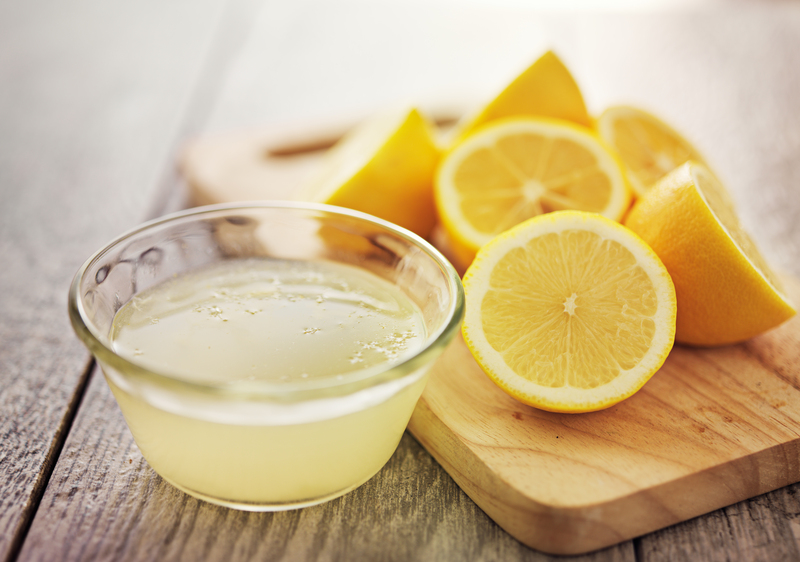Clean Slate: Tackle Grease with This Easy Enamel Oven Tray Guide
Posted on 08/09/2025
Clean Slate: Tackle Grease with This Easy Enamel Oven Tray Guide
Is the thought of scrubbing sticky, greasy oven trays giving you second thoughts about cooking? You're not alone! Enamel oven trays are a kitchen staple, but dealing with stubborn oven grease can feel like a nightmare. The good news? Achieving a clean slate for your enamel oven tray isn't as daunting as it seems. With the right steps, expert tricks, and simple household items, you can restore your trays to a pristine condition--no harsh chemicals required!

Understanding Enamel Oven Trays and Grease Build-up
Before diving into cleaning hacks, it's essential to understand what makes enamel oven trays unique and why grease can be so persistent. Enamel trays are made by fusing powdered glass to a metal base, resulting in a tough, glossy finish that resists rust and can withstand high heat. However, regular use causes food splatters and oils to bake onto the surface, forming hard, tacky layers of grease that can be tough to remove.
- Non-stick but not invincible: While the enamel coating is smooth, it's vulnerable to scratching and harsh chemicals.
- Why grease sticks: Exposed to high temperatures, fats oxidize, creating a stubborn, varnished film.
- Why regular cleaning matters: Built-up grease affects cooking performance and can even shorten the lifespan of your tray.
Why Choose Enamel Oven Trays?
Enamel oven pans are more than just a pretty addition to your kitchen arsenal. Here's why so many home cooks prefer them:
- Durability: With proper care, enamel trays can last for years without warping or rusting.
- Even Heat Distribution: Their heavy-gauge ensures consistent results when roasting or baking.
- Non-reactive Surface: Enamel won't interact with acidic foods, unlike some metals.
- No absorption: Flavors and odors don't linger, making these trays easy to turn from savory roast to sweet treats without worry.
- Easy to Wash: When clean, their glossy finish means food slides off easily--if you keep up with maintenance!
Step-by-Step Guide: How to Clean Grease from Enamel Oven Trays
Ready for a clean slate? Here's how to tackle even the toughest baked-on grease using simple, safe ingredients. This approach ensures your enamel oven pan remains sparkling and damage-free.
What You'll Need:
- Hot water
- Baking soda
- White vinegar
- Mild dish soap
- Soft non-abrasive sponge or cloth
- Old toothbrush
- Plastic scraper (optional)
- Paper towels
Step 1: Pre-soak for Easy Grease Removal
The secret to painless cleaning is softening stuck-on grease before you start scrubbing. Fill your sink, bathtub, or a large basin with hot water. Add a squirt of mild dish soap and stir until bubbly. Place your enamel oven tray in the soapy water and let it soak for at least 30 minutes--an hour is even better if there's a thick accumulation.
Step 2: The Baking Soda & Vinegar Method
Once the tray has soaked, drain the water and sprinkle a liberal amount of baking soda over the greasy areas. Slowly pour a small amount of white vinegar over the baking soda. The fizzing reaction helps break up burnt-on fat and residue. Let it sit for 10-15 minutes.
- TIP: For especially stubborn spots, make a paste of baking soda and water; spread it thickly and let it sit overnight before adding vinegar.
Step 3: Gentle Scrubbing
Armed with your non-abrasive sponge or a soft-bristled brush, gently scrub the surface in a circular motion. Avoid using steel wool, metal scouring pads, or abrasive powders as these can scratch the enamel coating and damage your tray. Use a plastic scraper or old toothbrush to target corners and grooves.
Step 4: Rinse and Inspect
Rinse the tray thoroughly under running water to remove any loosened grease and baking soda/vinegar residue. If stubborn spots remain, repeat the baking soda and vinegar process. Dry with a paper towel or air-dry before storing.
Step 5: Polishing for a Pristine Finish
For a final polish--and to truly achieve a clean slate--apply a tiny amount of mild dish soap and buff with a clean, slightly damp microfiber cloth. Rinse well, then dry. Your enamel oven tray should now look like new!
Alternative Natural Methods for Cleaning Enamel Oven Trays
Sometimes, you may not have white vinegar or baking soda handy, or you want to try something new. Here are a few other effective, eco-friendly cleaning solutions to keep your enamel baking tray in top shape:
- Lemon Juice: The natural acidity in lemon works similarly to vinegar. Squeeze fresh lemon juice over the tray, sprinkle with salt (for gentle abrasion), and scrub. Besides degreasing, it leaves your tray smelling fresh.
- Hydrogen Peroxide and Baking Soda: For exceptionally tough stains, make a spreadable paste by mixing hydrogen peroxide and baking soda. Apply, let sit, scrub, and rinse carefully.
- Commercial Enamel-Safe Cleaners: If DIY methods don't cut it, opt for a store-bought cleaner specifically labeled safe for enamel surfaces. Always follow the manufacturer's instructions to avoid damaging your tray.
How to Prevent Grease Build-Up on Enamel Oven Trays
While learning how to clean enamel oven trays is essential, prevention is even better. Here are the top expert-backed strategies to keep your trays grease-free:
- Line Baking Trays: Use parchment paper or a silicone baking mat whenever possible, especially for messy roasts or baked goods. This not only limits grease exposure but makes cleanup vastly easier.
- Clean Immediately: Address spills and splatters right after cooking. Once the tray cools down (but is still warm), wipe it with a damp cloth to prevent grease from setting.
- Use Cooking Racks: Place food on an oven-safe rack to keep it elevated and reduce direct contact with grease-laden tray bases.
- Avoid Cooking Sprays: Many conventional sprays leave behind a sticky residue. Opt for brushing or lightly dabbing oil instead.
- Regular Maintenance: Give your trays a deep clean at least once a month, even if they look clean on the surface.
What NOT to Do: Enamel Tray Cleaning Mistakes to Avoid
Enamel is sturdy, but it's not indestructible! Protect the glossy finish of your enamel roasting tray by sidestepping these common errors:
- Avoid steel wool and metal scrubbing pads. These scratch and dull the enamel, ruining its non-stick qualities.
- No harsh chemical oven cleaners. These can strip away the coating and leave toxic residues.
- Don't use sharp tools or knives. Chips or nicks in your tray create sites for more grease to adhere.
- Never shock with extreme temperature change. Don't plunge a hot tray into cold water--it can cause the enamel to crack.
Expert Tips: Long-Term Care for Enamel Oven Trays
Keeping your enamel oven trays in peak condition isn't just about cleaning; it's also about gentle daily use and mindful storage:
- Store with care: Stack trays with soft cloth in between to prevent chipping.
- Avoid overcrowding in the oven: Give air space to all sides to prevent uneven baking and sticky edges.
- Check for chips: Discontinue use if the enamel is cracked or chipped, as food and grease can penetrate, leading to rust and further damage.
- Occasionally "re-season" the surface: Apply a thin layer of cooking oil, heat in the oven at low temperature, and wipe excess off once cool. This restores shine and helps ward off grease clinginess.

Frequently Asked Questions about Cleaning Enamel Oven Trays
Is it safe to put enamel oven trays in the dishwasher?
Most enamel trays are dishwasher safe, but frequent washes can dull the finish over time. Hand washing is always gentler and prolongs their lifespan.
Can I use bleach on enamel trays?
Bleach is generally not recommended as it can damage the enamel and leave behind toxic residues. Stick to vinegar, baking soda, and mild dish soap.
What if my enamel tray is stained even after cleaning?
Stubborn stains may require several rounds of soaking and scrubbing with baking soda paste. Never try to scrape a stain with sharp tools--this risks permanent damage.
Are there foods I should avoid cooking on enamel trays?
Highly acidic foods are fine, but avoid broiling oily meats directly on the surface unless the tray is lined. Excessive direct heat and grease can bond with the enamel, making it harder to clean.
Conclusion: Embrace the Clean Slate Revolution
A sparkling clean enamel oven tray not only looks fantastic but promotes healthier, tastier cooking results. By following this easy, step-by-step guide, you're armed with every trick you need to tackle grease and maintain a kitchen that gleams. Remember, the key to lasting performance is regular maintenance, gentle cleaning, and the right preventive habits. With these simple efforts, your enamel oven tray will reward you with years of flawless service, letting you embrace a truly clean slate every time you cook!
- Want more kitchen cleaning wisdom? Bookmark this guide and share it with friends who could use an oven tray transformation. Don't let a little grease stop you from cooking up culinary masterpieces!
Ready, set, clean--your enamel oven tray's clean slate awaits!




